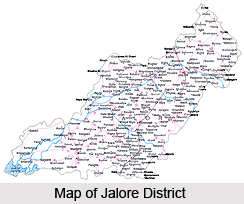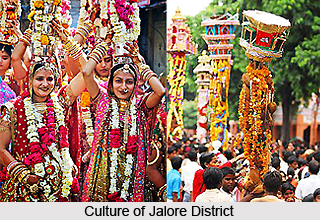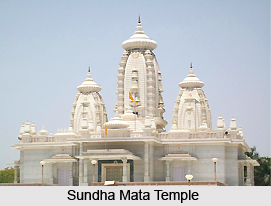 Jalore District is located towards the south-west of Rajasthan. The early name of Jalore was Jabalipur. The administrative headquarter of Jalore district is the Jalore city which is known as the Granite City of Rajasthan. A lot of mythological stories are associated with Jalore District. It is believed that Jalore district had existed since the time of Lord Rama in the Dwarpa Age. Historical evidences suggest that Jalore was a prosperous region and was ruled by the Pratihara Kings for quite some time. A number of brave men and women have added to the glory of Jalore as and when time passed by.
Jalore District is located towards the south-west of Rajasthan. The early name of Jalore was Jabalipur. The administrative headquarter of Jalore district is the Jalore city which is known as the Granite City of Rajasthan. A lot of mythological stories are associated with Jalore District. It is believed that Jalore district had existed since the time of Lord Rama in the Dwarpa Age. Historical evidences suggest that Jalore was a prosperous region and was ruled by the Pratihara Kings for quite some time. A number of brave men and women have added to the glory of Jalore as and when time passed by.
Location of Jalore District
Jalore District is located towards the south-western part of Rajasthan. The horizontal expanse of the district is between 24.48 degrees and 5 minutes north latitude and 25.48 degrees and 37 minutes north latitude. On the other hand longitudinally the district stretches between 71 degrees and 7 minutes east longitude and to the mid of 75.5 degrees and 53 minutes east longitude. Jalore District has an area of 10564.44 square kilometres. As per as the boundary of the district is concerned it can be said that the North Western border of the district is shared with Barmer, the North Eastern boundary is shared with Pali, towards South East is Sirohi and in south the ambit of Gujarat comes into force.
History of Jalore District
Jalore District has an old history. The area of Jalore was expanded by Prathihar King Naresh Nagbhatt II from the Bay of Bengal to the Arabian Sea. Before Indian Independence that is before the year 1947 Jalore was under the year Jodhpur Province. But soon after Independence Jalore became a separate district of Rajasthan. All together it can be said about Jalore District that it has a history which has a strong mythological lineage.
Geography of Jalore District
Jalore District is located at an altitude of 268 meters. It has a tropical or a half-tropical climate. The daily as well as the annual temperature of the region is quite high. The annual average rainfall of Jalore is 43.4 centimetres. The coldest month in Jalore district is January. During this time the temperature dips to around one or two degrees centigrade. On the other hand June is the hottest month of the year during when the temperature rises to as high as 41 or 42 degrees centigrade. Sometimes the temperature may be as high as 48 degrees centigrade. Jalore has huge deposits of old as well as new alluvial soils. The main river of the region is River Sukri which is a tributary of River Luna.
 As far as the fauna of Jalore District is concerned in the present age a number of wild animals are to be found in the region.
As far as the fauna of Jalore District is concerned in the present age a number of wild animals are to be found in the region.
Demography of Jalore District
According to the census of 2001, Jalore District has a population of 1448940. Density of population in the district is 136 persons per square kilometre. The number of males in the district is 737880 and the number of females is 711060. In Jalore there is more number of rural populations in comparison to the urban population of the district. The rural and urban population of Jalore is 1338946 and 109994 respectively. The literacy rate of Jalore is as low as 46.05 percent. As far as literacy rate is concerned, 64.7 percent males are literate and only 27.8 percent females are literate in the district of Jalore.
Culture of Jalore District
For centuries Jalore District has been a centre of culture and literature in the desert state. The Hindu kings of the region inspired the growth of Shaiva and Jaina ways of life. Thus religious influence is apparent on the art and literature of the district. The district had been a centre of studies in ancient times. Jalore is also closely associated with Maharana Pratap Singh.
A number of vibrant and colourful fairs are celebrated in the district of Jalore throughout the year. The fairs that are celebrated are mostly religious fairs. Festivals like Diwali, Holi, Dushera, Gangaur Festival, Teej Festival, Id-Ul-Fitr, Id-ul- Zuha, Christmas, Raksha Bandhan, Janmashthami, Akshya Tritia are celebrated in Jalore with lots of zeal and enthusiasm.
Folk Dance is an important component of life for the people of Jalore. Dances like the Dhol Dance, Dandiya, Loor Dance, Shakur Dance, Matki Dance are the most common dances into which the people of Jalore engage themselves during times of festivity.
Administration of Jalore District
Jalore District has been divided into five sub-units namely Ahore, Jalore, Bhinmal Raniwara and Sanchore. There are also 767 revenue villages in the district. For revenue administration Jalore, Ahore, Bhinmal, Raniwara, Sanchore, Sayala and Bagoda had been provided with Tehsil Officer whereas Bhadrajun and Chitalwana have Sub-Tehsil Office. For proper functioning of developmental activity Seven Panchayat Samiti Offices have been established at Jalore, Bhinmal are Sayala. Three Municipalities are situated at Jalore, Bhinmal and Sanchore. In Jalore 264 Gram Panchayat villages have been formed.
For instituting democratic laws of governance Jalore-Sirohi is jointly one parliamentary constituency. There are five legislative assembly areas namely Jalore, Ahore, Bhinmal, Raniwara and Sanchore Members of Lok Sabha and Legislative Assembly.
Economy of Jalore District
The economy of Jalore District is mainly dependant on agriculture and animal husbandry. Food grains, oilseeds, pulses and cotton are the main crops of the region.

Jalore is the granite capital of Rajasthan. There are several other minerals which are found in abundance here. As a result presently a number of mineral based industries have sprung up. But there are hardly any large and medium scale industries in this district. The small scale industries that are found in the region are that of granite slabs and tiles, marble cutting and polishing, mustard seed crushing, skimmed milk powder, butter and ghee. Handloom work in Jalore District is greatly developed. Leather shoes are an important attraction of Jalore District. Altogether there are four industrial areas in the district. Jalore has a wide potential in industrial sector that has to be exploited properly. The main industries of the region are agro-based industries, granite-based industries, engineering units and some other industries.
Tourism of Jalore District
Sundha Mata Temple is the most important tourist destination of Jalore District. Several people throng the temple campus in order to offer their dedication to the Goddess. Apart from the Sunda Mata Temple there are other places of tourist attraction in Jalore. Both historical and religious places in the district of Jalore have made it attractive in terms of tourism. The various historical places found in Jalore testify its glorious past. There are plenty of forts in the district of Jalore. The architecture and designs of the fort that are present in Jalore is bound to attract every visitor towards it.






